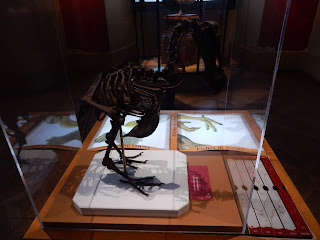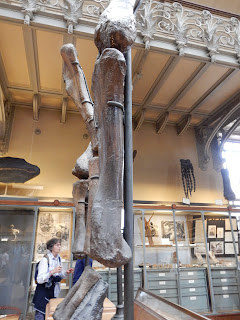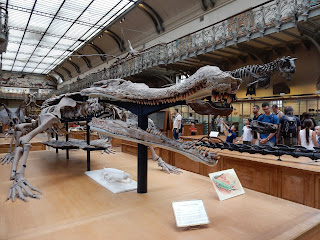The location of IPC 2018 was well chosen, taking place essentially next door to the botanical garden Jardin des plantes. It is here that the main galleries of the French National Museum of Natural History (Muséum national d'Histoire naturelle) are found. (The museum is divided into several sites scattered throughout France, but most of the publicly accessible galleries are at Jardin des plantes, which is also considered to be the museum's original location.)
Our first taste of the museum was at the conference's cocktail dinatoire, hosted at the museum's Gallery of Evolution. This gallery is probably most famous for its parade of African animals. Here I decided to take a shot focusing on the pangolin (with bonus marabou stork).
Though there was a lot to see in the Gallery of Evolution, the halls were dimly lit for most part, making photography difficult. Hidden away in a corner was an exhibit dedicated to recently extinct animals, featuring this skeletal mount of a dodo.
Some frolicking platypuses. I've rarely seen taxidermied monotremes put in such dynamic poses.
One section of the marine-themed exhibits in the gallery was focused on narwhals.
In a separate gallery was a temporary exhibit showcasing the Tyrannosaurus specimen "Trix", the first original Tyrannosaurus specimen to be on display in France.
In the same hall as "Trix" was a statue of the father of vertebrate paleontology himself, Georges Cuvier. For some reason he is depicted using his index finger to carve a rift through Africa on a globe.
The dinatoire had given us a good taster of the museum, but it hadn't yet given us a chance to visit the legendary Gallery of Paleontology and Comparative Anatomy. So (as I mentioned previously) on the third day of the conference some of us went to check that out. Along the way we passed by this carousel of extinct and endangered animals, featuring an elephant bird, a glyptodont, a Meiolania, and Sivatherium among others.
This was the sight that greeted us when we entered the Gallery of Paleontology and Comparative Anatomy. I guarantee that it is ten thousand times more impressive in person than what this photo suggests. Calling it a literally mind-blowing experience would barely be an exaggeration. I feel like everyone in my party was struck speechless for a few moments.
There was a lot to take in. It would have been impossible to properly examine everything even if we had spent an entire day there (partly due to the quantity of specimens and partly because some of the specimens weren't situated in places conducive to viewing), but we gave it a good shot. Here is a skeleton of a juvenile gorilla.
The marsupial case featured a thylacine skeleton as its centerpiece.
A long-beaked echidna.
The mustelid case, featuring a juvenile ratel.
A giraffe mounted with its nuchal ligament.
Naturally, Daniel and I spent a long time staring at the bird skeletons. Here is a case full of sunbirds.
A pair of kagu.
A screamer. It took us a few moments to figure out what it was (the scientific name on the label was outdated), but the carpometacarpal spurs probably should have clued us in.
Spoonbills.
A pelican mounted with its throat pouch.
A manatee skull.
An ocean sunfish.
A two-toed sloth turning its head around.
A bowhead whale mounted with baleen.
A balcony halfway up the stairs gave us the chance to look at the comparative anatomy exhibits from above.
The next floor up were the vertebrate paleontology displays. Here are some limb bones of Cetiosaurus.
A Sarcosuchus.
An Arctocyon, one of many Paleocene mammals of uncertain affinities.
I was surprised to see a restoration of a fully feathered dromaeosaurid included on one of the exhibit signs.
The French specimen of Compsognathus. Though Compsognathus was formerly considered the smallest non-avian dinosaur, I can confirm that it's not that small. At about the size of a turkey, it's certainly larger than the likes of Mei and Parvicursor.
A cast of the smaller holotype of Compsognathus.
The type specimen of Mosasaurus!
Another floor up hosted the museum's invertebrate paleontology displays. It was cool to see the holotype of Meganeura, though my photos of it turned out subpar.
After the museum, Daniel and I were interested in going to the small zoo (Ménagerie du Jardin des plantes) nearby, but Antoine (being a palynologist) decided to give us a tour of the botanical attractions in the garden first. Of course, I couldn't resist being distracted by the first sign of animal activity.
A Metasequoia, well known to paleobotanists who work on the Late Cretaceous (and onward).
The greenhouses were impressive. One simulated a tropical forest environment and included a staircase the allowed visitors to experience the "forest canopy". Though it must be said that being in a "tropical forest" without hearing any animal calls whatsoever was mildly eerie.
Another greenhouse arranged its exhibits in a more phylogenetically-based sequence, starting out with mosses and lycopods.
Platycerium, an unusual fern.
Some fossils of bennettitaleans.
By the time we stopped looking at plants, the Ménagerie was on the verge of closing. I did, however, take some time away from the conference to visit it on the following day, and will be covering it in the next post.
Tuesday, July 17, 2018
French National Museum of Natural History
Labels:
Avialans,
Conference,
Shock horror a non maniraptor,
Trip
Subscribe to:
Post Comments (Atom)















































No comments:
Post a Comment